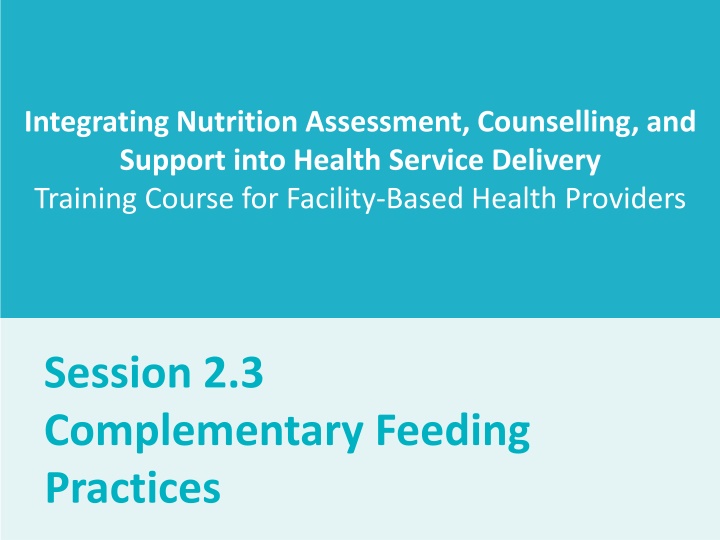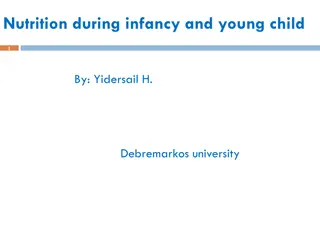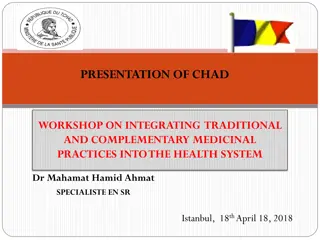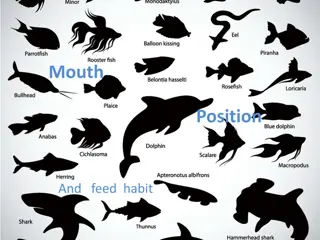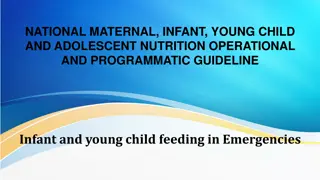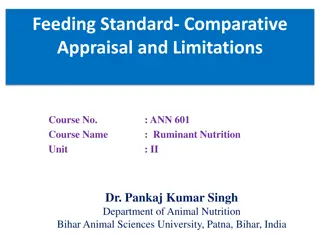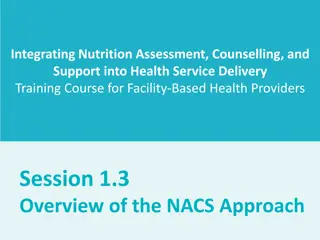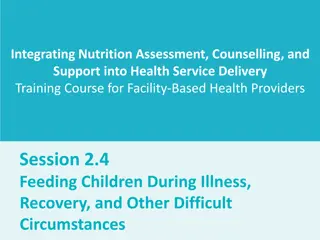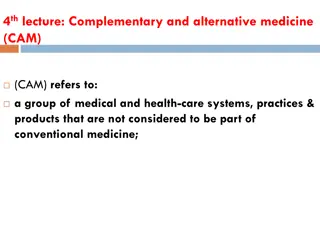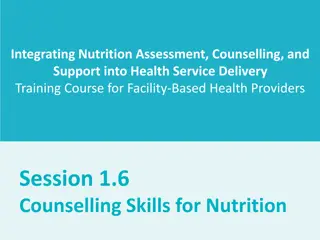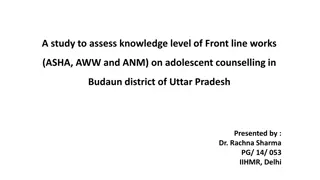Integrating Nutrition Assessment and Counselling: Complementary Feeding Practices
This training course focuses on educating facility-based health providers on complementary feeding practices, emphasizing the importance of introducing solid foods along with breastfeeding at 6 months. The session covers topics like nutrition gaps in breast milk, optimal feeding principles, and utilizing locally available foods for complementary feeding.
Download Presentation

Please find below an Image/Link to download the presentation.
The content on the website is provided AS IS for your information and personal use only. It may not be sold, licensed, or shared on other websites without obtaining consent from the author.If you encounter any issues during the download, it is possible that the publisher has removed the file from their server.
You are allowed to download the files provided on this website for personal or commercial use, subject to the condition that they are used lawfully. All files are the property of their respective owners.
The content on the website is provided AS IS for your information and personal use only. It may not be sold, licensed, or shared on other websites without obtaining consent from the author.
E N D
Presentation Transcript
Integrating Nutrition Assessment, Counselling, and Support into Health Service Delivery Training Course for Facility-Based Health Providers Session 2.3 Complementary Feeding Practices .
Session Objectives By the end of the session, participants will be able to: 1. Describe what complementary feeding is and why it is needed 2. Discuss nutrition gaps in breast milk after 6 months and foods to supplement the gaps 3. Describe optimal principles and practices for complementary feeding 4. Demonstrate ability to use locally available foods for complementary feeding Integrating Nutrition Assessment, Counselling, and Support into Health Service Delivery 2
TOPIC 1. INTRODUCTION TO COMPLEMENTARY FEEDING Integrating Nutrition Assessment, Counselling, and Support into Health Service Delivery 3
Introduction to Complementary Feeding Complementary feeding: giving other foods in addition to breast milk to a baby starting at 6 months (180 days) of age Timely introduction of complementary foods is important: Too early risk of infection and worsened nutritional intake; infant may not be developmentally ready Too late breast milk alone no longer provides the infant with all the energy and nutrients needed Integrating Nutrition Assessment, Counselling, and Support into Health Service Delivery 4
Introduction to Complementary Feeding During the period of complementary feeding, the young child gradually becomes accustomed to eating family foods. Breastfeeding should continue until the child is at least 2 years old. Integrating Nutrition Assessment, Counselling, and Support into Health Service Delivery 5
TOPIC 2. NUTRIENT GAPS IN BREAST MILK AFTER 6 MONTHS Integrating Nutrition Assessment, Counselling, and Support into Health Service Delivery 6
Brainstorm What nutrient gaps exist in breast milk after 6 months of age? Integrating Nutrition Assessment, Counselling, and Support into Health Service Delivery 7
Nutrient Gaps in Breast Milk after 6 Months The nutrient gaps left by breast milk after age 6 months include: Energy Protein Iron Zinc Calcium Vitamin A B Vitamins and Iodine Complementary foods need to fill these gaps Integrating Nutrition Assessment, Counselling, and Support into Health Service Delivery 8
Energy Gap Complementary foods need to be energy rich. Energy-rich foods include maize, millet and wheat flour, rice, cassava, potatoes, matoke, and yams. Fats and oils are also good sources of energy and an important component of the diets of infants and young children. ~ 30-45% of calories from breast milk and complementary foods should be provided by fat for a child under 2 years. Fats also provide essential fatty acids and improve the absorption of fat-soluble vitamins (vitamins A, D, E, and K). Integrating Nutrition Assessment, Counselling, and Support into Health Service Delivery 9
Energy Gap Integrating Nutrition Assessment, Counselling, and Support into Health Service Delivery 10
Protein Gap Proteins are required for growth, development, repair, and maintenance of the body. Slightly less than half of a 12-23 month child s protein requirements need to come from complementary foods. Protein-rich foods include: Animal sources: milk and milk products, fish, and eggs Plant sources: beans, groundnuts, peas, simsim, and soybeans Integrating Nutrition Assessment, Counselling, and Support into Health Service Delivery 11
Foods Rich in Protein Integrating Nutrition Assessment, Counselling, and Support into Health Service Delivery 12
Iron Gap Iron is needed to make new blood cells to assist in growth and development. Insufficient iron causes: Anemia Negative and permanent effects on brain development Iron stores at birth are high but are gradually used up over the first 6 months. Breast milk is low in iron (though the iron is well-absorbed). Main source of iron after 6 months is complementary foods. Integrating Nutrition Assessment, Counselling, and Support into Health Service Delivery 13
Iron Gap Integrating Nutrition Assessment, Counselling, and Support into Health Service Delivery 14
Iron Gap Iron-rich foods include: Animal sources: meat, organs/offal (liver, heart, and blood), and seafood such fish and crab Plant sources: legumes or pulses such as beans, peas, and lentils; nuts and seeds; dark green leafy vegetables such as nakati, boo/gobe, malakwang, dodo, pumpkin leaves, yam leaves, cassava leaves, and potato leaves; seaweed Foods/condiments fortified with iron, such as fortified wheat flour Integrating Nutrition Assessment, Counselling, and Support into Health Service Delivery 15
Iron Gap The amount of iron that a body absorbs depends on: Amount of iron in the food Source of iron: animal-source iron is better absorbed than plant- source iron Consumption of foods rich in vitamin C, which facilitate absorption (e.g., fruits such as oranges, tangerines, pineapples, and pawpaw) Consumption of foods that interfere with absorption, such as tea and coffee, high fibre foods (e.g., yams), and calcium-rich foods (e.g., milk) Iron-status of the individual: iron-deficient individuals will absorb more iron from the diet Integrating Nutrition Assessment, Counselling, and Support into Health Service Delivery 16
Calcium Gap Calcium is required for healthy bones and teeth, and needed for muscle function, nerve transmission, and contraction and dilation of blood vessels. Foods that are rich in calcium include: Animal sources: milk and milk products (yoghurt, cheese), small fish with bones Plant sources: leafy greens (cabbage, kale, collards); legumes or pulses such as beans, peas, and lentils Integrating Nutrition Assessment, Counselling, and Support into Health Service Delivery 17
Zinc Gap Zinc is important for immune function and normal growth and development during pregnancy, childhood, and adolescence. A daily intake of zinc is required because the body has no zinc storage system. A large portion (as much as 85%) of the zinc requirements for children 6-23 months needs to come from complementary foods. Integrating Nutrition Assessment, Counselling, and Support into Health Service Delivery 18
Zinc Gap Foods that are rich in zinc include: Animal sources: meat (chicken and beef); organ meats/offal (liver, blood); fish and shellfish (oysters, crab); dairy products; egg yolk Plant sources: whole grains; legumes or pulses such as beans, peas, and lentils; nuts and seeds Integrating Nutrition Assessment, Counselling, and Support into Health Service Delivery 19
Vitamin A Gap Vitamin A deficiency causes poor vision, lowered immunity, and dry skin and mucous membranes. Vitamin A is required in minimal amounts and is stored for a limited period in the body. Breast milk supplies a large part of vitamin A the child needs if the mother s diet is not deficient. However, in many situations, the vitamin A status of the mother may be inadequate, and a greater proportion of a child s requirements will need to come from complementary foods. Integrating Nutrition Assessment, Counselling, and Support into Health Service Delivery 20
Vitamin A Gap Integrating Nutrition Assessment, Counselling, and Support into Health Service Delivery 21
Vitamin A Gap Foods rich in vitamin A include: Plant sources: dark green leafy vegetables (e.g., spinach) and orange-fleshed vegetables and fruits (e.g., carrots, pumpkins, orange-fleshed sweet potatoes, mangoes, papaya) Animal sources: organ foods/offal from animals, milk and milk products, egg yolk Margarine and foods fortified with vitamin A, such as cooking oil Integrating Nutrition Assessment, Counselling, and Support into Health Service Delivery 22
Other Nutrient Gaps Some B vitamins (thiamin and riboflavin) and iodine may also be inadequate in breast milk after 6 months of age, particularly if mothers are deficient in these nutrients and thus less is provided through breast milk. Integrating Nutrition Assessment, Counselling, and Support into Health Service Delivery 23
Summary: Gaps To be Covered by Complementary Foods at 12-23 Months 100% Percentage of daily needs 75% Gap 50% Provided by 550 ml breast milk 25% 0% Energy Protein Iron Vitamin A Zinc Calcium Integrating Nutrition Assessment, Counselling, and Support into Health Service Delivery 24
TOPIC 3. PRINCIPLES FOR OPTIMAL COMPLEMENTARY FEEDING Integrating Nutrition Assessment, Counselling, and Support into Health Service Delivery 25
Principles for Optimal Complementary Feeding Complementary feeding practices should reflect the FATVAH principles: Frequency of feeding Amount/quantity of food Thickness of food Variety of food Active feeding Hygiene Integrating Nutrition Assessment, Counselling, and Support into Health Service Delivery 26
FATVAH Principles Frequency of feeding is important: Too few meals = child will not meet energy requirements Too many meals = child will reduce breast milk intake, which may reduce the child s overall nutrient intake and diet quality Integrating Nutrition Assessment, Counselling, and Support into Health Service Delivery 27
FATVAH Principles Frequency of feeding is dependent on: Stomach size: Infants have small stomachs and can only eat small amounts at each meal. Energy requirements: Older infants/children will need more meals to meet their requirements. Energy density of the food: Foods that are less energy dense must be provided in larger quantities and more frequent meals. Integrating Nutrition Assessment, Counselling, and Support into Health Service Delivery 28
FATVAH Principles Amount The stomach of a young child is small and at 8 months of age (~8 kg) the stomach can hold about 240 ml (1 cup) at one time. The amount given to a child should increase as the child grows. Start with 2 3 small spoonfuls of food twice a day and increase gradually as summarized in the following table. Integrating Nutrition Assessment, Counselling, and Support into Health Service Delivery 29
Recommended Food Texture, Frequency, and Amount, by Age Age Texture Frequency Amount Start with thick porridge, well mashed foods; continue with mashed family foods Start with 2-3 tbsp per feed, increasing gradually to of a 250 ml cup 2-3 meals per day plus frequent breastfeeding 6 8 months Based on a child s appetite, 1-2 snacks may be offered Use only treated water to prepare foods Finely chopped or mashed food and foods that the baby can pick up with his/her fingers 3-4 meals per day plus frequent breastfeeding 9 11 months cup at each meal Based on a child s appetite, 1-2 snacks may be offered Wash children s hands before they feed themselves Family foods, chopped or mashed if necessary 3-4 meals per day plus frequent breastfeeding 12 23 months to 1 250 ml cup Wash children s hands before they feed themselves Based on a child s appetite, 1-2 snacks may be offered Integrating Nutrition Assessment, Counselling, and Support into Health Service Delivery 30
FATVAH Principles Thickness Complementary food should be thick enough so that it stays on a spoon and does not drip off. Generally, foods that are thicker or more solid are more energy- and nutrient-dense than thin, watery or soft foods. As a child develops, the child is able to handle increasingly more solid foods that are finely chopped. Integrating Nutrition Assessment, Counselling, and Support into Health Service Delivery 31
FATVAH Principles Integrating Nutrition Assessment, Counselling, and Support into Health Service Delivery 32
FATVAH Principles Variety Complementary feeding should include a variety of foods to ensure the child is getting a variety of nutrients. Serve foods with a range of colours yellow, red, orange, brown, green, and white. Plant and animal sources will help ensure that the child is getting a variety of nutrients. Integrating Nutrition Assessment, Counselling, and Support into Health Service Delivery 33
FATVAH Principles Active feeding How, when, where, and by whom the child is fed are important. Active feeding (also called responsive feeding ) means engaging a child while feeding to encourage the child to eat. Integrating Nutrition Assessment, Counselling, and Support into Health Service Delivery 34
FATVAH Principles Active feeding practices include: Talking to the child and making eye contact while feeding the child Minimizing distractions Feeding infants directly and assisting older children when they feed themselves Feeding slowly and patiently, and encouraging children to eat, but not forcing them Integrating Nutrition Assessment, Counselling, and Support into Health Service Delivery 35
FATVAH Principles Hygiene Practice good hygiene when preparing food and feeding children: Always wash hands with soap or ash and clean flowing or poured water before preparing food and feeding baby. Use only treated water for drinking and mixing into food. Store treated drinking water in a covered container and serve by pouring. Cover food when storing. Integrating Nutrition Assessment, Counselling, and Support into Health Service Delivery 36
WASH WASH includes: Water access, quantity, and quality Sanitation safe handling and disposal of human excreta, management of waste, and control of disease vectors (such as mosquitoes and flies) Hygiene handwashing with soap/ash, treatment and safe storage of drinking water, safe preparation and storage of food Integrating Nutrition Assessment, Counselling, and Support into Health Service Delivery 37
Importance of WASH Integration in Health Care and Nutrition Programs WASH practices help to prevent water- and food- related diarrhoeal diseases. Integrating WASH practices helps improve overall health outcomes. Focus on practices that are feasible for each household. Negotiate a commitment to try 1 2 practices that seem feasible, worth changing and safe, from the point of view of the household. Integrating Nutrition Assessment, Counselling, and Support into Health Service Delivery 38
Water: Priority Actions Treat drinking water Chlorination (Aqua Safe, Water Guard) Solar disinfection Boiling Filtration Use treated water to wash or mix into foods that won t be cooked further Store treated water safely Covered container with narrow neck Serve by pouring, or using clean ladle Integrating Nutrition Assessment, Counselling, and Support into Health Service Delivery 39
Sanitation: Priority Actions Handle and dispose of faeces safely: Latrine use by all household members. Maintain latrines according minimum standards, keep clean and adapt for those with limited mobility. Maintain a clean environment: Keep animals out of house and away from food preparation. Sweep compound to remove animal faeces. Ensure that toddlers do not crawl in areas with faeces. Integrating Nutrition Assessment, Counselling, and Support into Health Service Delivery 40
Hygiene: Priority Actions Proper handwashing: Using soap or ash every time you wash your hands Washing hands under poured or flowing water Before handling/preparing/eating food Before feeding others or giving medicines Integrating Nutrition Assessment, Counselling, and Support into Health Service Delivery 41
Hygiene: Priority Actions Proper handwashing (cont d): After going to the toilet or cleaning others who have defecated; blowing your nose; coughing/sneezing; handling animal/animal waste Before and after tending to someone who is sick Installing a tippy tap near latrine and food preparation areas can promote handwashing Integrating Nutrition Assessment, Counselling, and Support into Health Service Delivery 42
Hygiene: Priority Actions Prepare, handle, and store food safely Keep food preparation areas and serving/eating utensils clean. Separate raw and cooked food. Cook food thoroughly. Keep foods at safe temperatures. Use treated water. Integrating Nutrition Assessment, Counselling, and Support into Health Service Delivery 43
Group Work Prepare a nutritious complementary meal with the food provided. Integrating Nutrition Assessment, Counselling, and Support into Health Service Delivery 44
Summary Start providing children with complementary foods, in addition to breastfeeding, at 6 months. Continue breastfeeding until the child is 2 years of age. Gradually increase frequency, amount, and texture as child gets older. Provide a variety of foods animal and plant sources and a variety of colours. Integrating Nutrition Assessment, Counselling, and Support into Health Service Delivery 45
Summary (Contd) Actively engage the child while feeding to encourage the child to eat Practice good hygiene, including good food hygiene Wash hands with soap/ash and clean flowing/poured water before preparing food or feeding among other key times Treat drinking water and water used in non- cooked foods Integrating Nutrition Assessment, Counselling, and Support into Health Service Delivery 46
Summary (Contd) Store treated drinking water in a covered container with a small mouth; pour water to serve Cover food with a cloth, net, or lid Avoid contamination of cooked food with raw food Cook and reheat food thoroughly Integrating Nutrition Assessment, Counselling, and Support into Health Service Delivery 47
Thank you! Questions, additions, and clarifications? Integrating Nutrition Assessment, Counselling, and Support into Health Service Delivery 48
